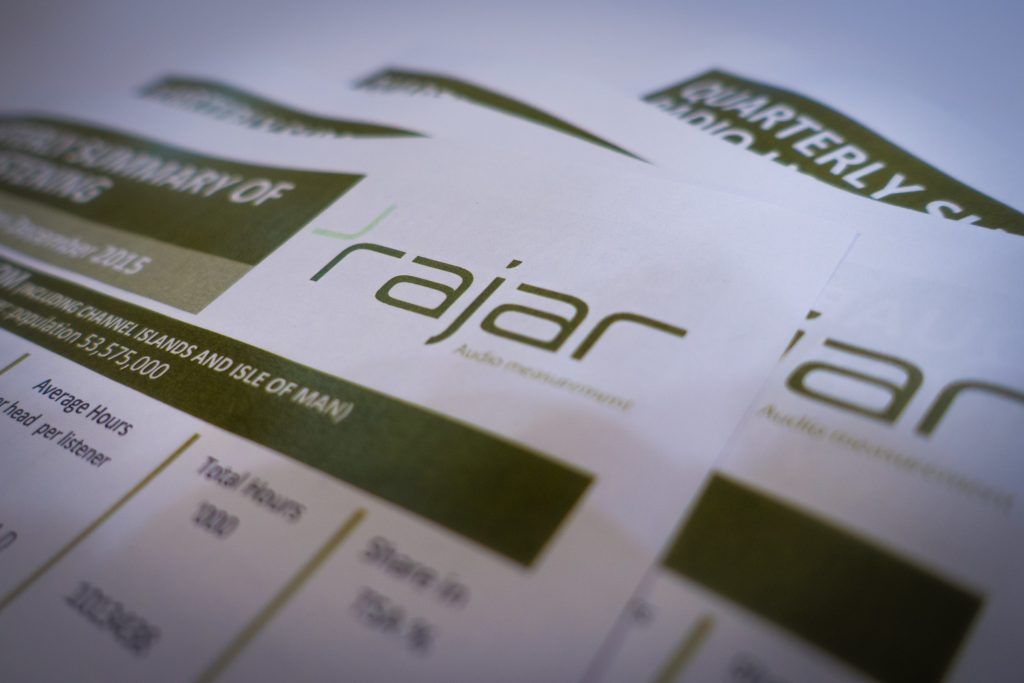
This post is brought to you in association with RALF from DP Software and Services. I’ve used RALF for the many years, and it’s my favourite RAJAR analysis tool. So I am delighted that I continue to be able to bring you this RAJAR analysis in association with RALF. For more details on the product, contact Deryck Pritchard via this link or phone 07545 425677.
The start of August means the second set of RAJAR results of the year. One thing it’s always worth remembering is that in Q2 each year, RAJAR updates its demographics – that is to say, that increase the size of the population to reflect the make-up of the country. That can have some knock-on effects on some of the figures.
New Stations
There are a couple of new stations to look at this quarter. Bauer’s Scala Radio launched at the end of March, so this is its first quarter of results. In posted a modest 258,000 reach and 1.5m hours. The station is the new home of Simon Mayo and plays a mixture of classical music that Bauer hopes will reach beyond the confines of the traditional classical music services. Mayo himself saw a reach of 143,000 in his first quarter, for his Mon-Sat 1000-1300 show. In other words, he accounts for 55% of the overall audience.
From what I can tell, Bauer has given the station some significant backing, with significant advertising in London as well as in broadsheet newspapers.
See below for how that compares with the existing classical music services.
Bauer’s other new station reporting for the first time this quarter is Country Hits Radio. That achieved a reach of 208,000 and 783 hours. Not far off Scala in reach, although hours are half of Scala’s.
Although it’s not new, it’s probably worth revisiting Virgin Radio, since this marks the end of the second quarter they’ve been broadcasting with Chris Evans. The good news is that they’ve had another good bump in listening up 18.8% to 1.5m in reach and up 29.9% to 10.1m hours. Evans himself is up 6.0% to 1.1m across all the Virgin Radio Network of stations.
I’d be a little concerned that those jumps, while probably continuing for a few more quarters, are probably going to increase somewhat more slowly in future reports. I suspect that we’ll see some more marketing activity in the autumn, although the station continues to get cross-promotion in News UK newspaper titles (It’d be smart perhaps, if they changed the copy a bit more frequently).
Overall Listening
All radio listening is down a little this quarter. Reach is down 0.3% on the quarter but only 0.1% on the year, remaining at 89% overall. So, 48.8m adults aged 15+ listen to the radio each week.
Hours is a little more concerning being down 0.8% on the quarter although only down 0.1% on the year to 1.01bn. They continue to hang on over that billion mark.
Amongst 15-24s, the age group that listens least, the reach has dipped below 80% for the first time – with 79% of that age group listening to the radio each week. The time spent listening has also fallen to its lowest ever for this demographic. While it’s true the overall population of 15-24s ebbs and flows over time, the reach percentage tells a story.
It hasn’t been a great quarter for the BBC, with reach down 1.0% on the quarter and down 1.1% on the year to 34.1m. More concerningly, hours have fallen a significant 4.9% on the quarter and are down 4.8% on the year to 500m.
At the same time, Commercial Radio has seen its reach flat on the quarter (0.0%), but up 1.8% on the year to 36.1m, while hours grew 4.1% on the quarter and are up 4.9% on the year to 487,000.
Commercial Radio has had more reach than the BBC for a while, and now it’s closing in on the BBC’s hours. The BBC maintains a 49.3% to 48.0% lead in terms of market share.
A thought: listening to on-demand audio like podcasts is not included in RAJAR. Were it to be, it’s likely it would help boost the BBC’s hours more than such a move would boost commercial radio’s. There are complications in doing this of course, since RAJAR is used to set commercial advertising costs. But there are technical ways around it.
National Radio and Groups
The BBC has a new Controller of Pop in Lorna Clarke, and her responsibilities will include being ultimately in charge of Radio 1, 1Xtra, Radio 2, 6 Music and Asian Network. I’m not sure if she’s in position yet, but she has a mixed bag of RAJAR results this time around.
In the week after Radio 1 repeated what has quickly become arguably the most innovative thing happening in radio at the moment – Hide and Seek – they had a good set of results. Reach was up 2.8% on the quarter and up 3.5% on the year to 9.6m. Hours also grew, up 2.5% on the quarter and up 0.9% on the year to 60.2m.
Radio 1Xtra was up 5.0% on the quarter and up 6.7% on the year to 1.1m although hours fell 4.7% on the quarter while still being up 0.5% on the year to 4.3m.
Radio 2 has had more of a tumultuous period. Last quarter, everyone was paying close attention because Chris Evans had left, and there’d been some big changes across the schedule. In the end, everything stayed very smooth. But it seems there’s been a bit of a delay, and this time around the station is down 5.0% in reach on the quarter and down 2.3% on the year to 14.6m. That represents a fall of more than 750,000 reach in one quarter.
But here’s the thing – there’s no obvious sign that everyone had gone to one place in particular. They definitely haven’t all headed off to Virgin Radio. More likely, they’ve gone to a multitude of specialist digital stations – more of which anon.
In hours terms, the fall is bigger. Radio 2 is down 6.1% on the quarter and down 8.2% on the year 166.6m. Of course, Radio 2 remains by far the biggest radio station in the country, but significant schedule changes can and will have consequences.
Radio 3 has had a broadly decent set of results. They remain with just over 2m reach, with a slight fall of 0.6% on the quarter, but a gain of 6.3% on the year. Hours are better, growing 6.3% on the quarter and up 14.8% on the year to 13.1m. That’s a very healthy number for Radio 3 to be going into Prom season with – typically the station’s biggest quarter of the year.
Radio 4’s audience has seemed to move up and down dependent on interest/boredom with Brexit. Recall that at the end of last quarter we were going to into a knife edge Brexit period of potentially leaving with no deal. Then there was that extension until the 31October and maybe everyone drifted away and got bored? Yes, there has been a Prime Ministership up for grabs, but nonetheless, Radio 4’s reach has dipped 4.0% on the quarter, although only 0.2% on the year to 10.6m. Hours are down 6.7% on the quarter and down 5.1% on the year to 113.1m.
5 Live’s Controller Jonathan Wall is heading off to run BBC Sounds, and he leaves the station with a reach of 5.2m – down 3.0% on the quarter but up 10.8% on the year. Hours are down 6.3% on the quarter and up 5.0% on the year. This period covered the end of the football season, and obviously Brexit may have had an impact there as well.
Over at 5 Live Sports Extra, reach growing 110% on the quarter and 26.5% on the year suggest that the early stages of the Cricket World Cup may have had an impact. Hours were up 451% on the quarter and 87.6% on the year.
6 Music didn’t break any records this quarter, falling 9.1% on the quarter in reach and down 6.5% on the year to 2.3m. Hours also fell 13.5% on the quarter and 11.5% on the year to 21.5m. Like Radio 2, the major rejig of the weekday line-up has taken a while to show through in figures. It’d be a fool who bets against them getting that audience back however.
The World Service was down a bit too – again maybe a Brexit boredom issue? Reach was down 1.8% on the quarter and down 4.1% on the year to 1.5m, while hours were down 6.3% on the quarter and down 10.3% on the year to 6.6m.
It’s interesting that the introduction of Scala Radio hasn’t had any real impact on Radio 3. Nor has it had much impact on Classic FM. The station recorded a strong set of reach figures, up 6.4% on the quarter and up 9.2% on the year to 5.6m. Hours were down a little, falling 2.7% on the quarter, but they were up 6.5% on the year.
Exactly how do the three classical stations interact? I’ve put together this little diagram to show you. It’s not precisely to scale, but should give you an idea.
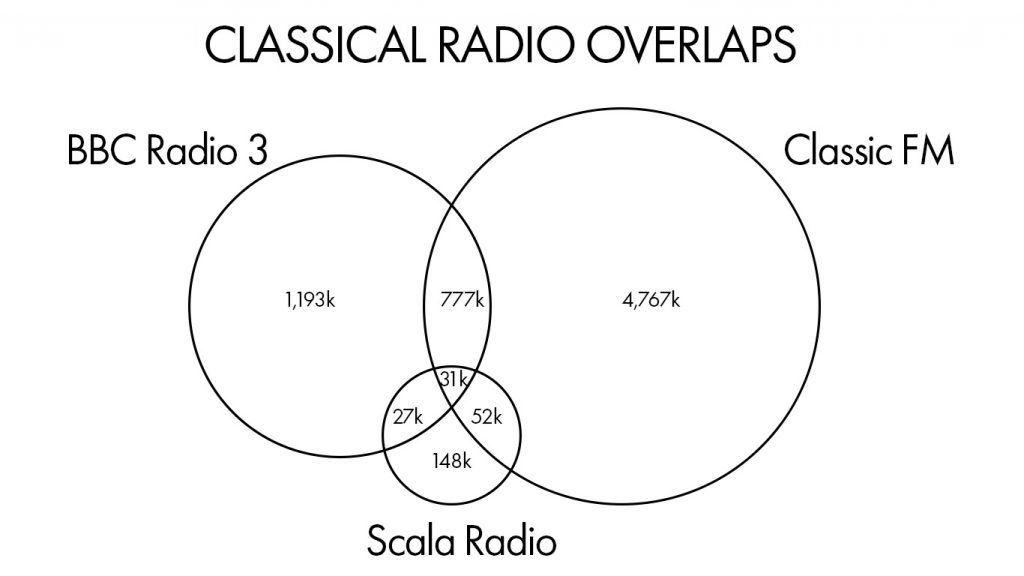
In total, there are 31,000 people who listen to all of Radio 3, Classic FM and Scala. Some only listen to two of them (e.g. 777,000 who listen to Radio 3 and Classic FM but not Scala) and some don’t listen to any of the “competition.” 85% of Classic FM’s listeners don’t listen to either of the other two. On the other hand only 59% of Radio 3’s listeners don’t listen to other classical stations, and 57% of Scala’s audience do likewise.
I guess the most interesting number is the 148,000 who listen to Scala but don’t listen to other classical services. These are the people that Scala was aimed at according to their press material. And 148,000 of them isn’t far off the 143,000 listeners that Simon Mayo has!
Again, it’s almost certainly far too early to making much of these things, and the musical output of each station seems quite distinct right now. Perhaps something to come back to in a few quarters time.
Talksport saw some good reach results, up 1.9% on the quarter and up 7.5% on the year to 3.1m. Hours weren’t as good, down 3.9% on the quarter and down 4.6% on the year to below 20m again.
Mixed results for its sister station Talksport 2, with reach up 3.5% on the quarter and up 60.8% on the year, but hours were down 9.0% on the quarter while up 97.2% on the year. Not quite as much cricket as there had been in the previous quarter.
Finally in the Wireless stable, some good news for Talkradio, with reach up 13.9% on the quarter and up 62.9% on the year to 386,000 (a record for the station), while hours were up 37.7% on the quarter and 124.9% on the year to 1.9m. It’s notable that News UK is making quite a lot of cross promotions with outlets like The Sun. For example, the debate between Boris Johnson and Jeremy Hunt was co-branded as both The Sun and Talkradio, meaning both logos were visible when footage was shared with major broadcasters.
We shouldn’t go much further without mentioning Kisstory who overtook 6 Music this quarter to become the biggest digital only radio station. That’s quite a landmark for the Bauer station. Reach grew a massive 25.9% on the quarter and 14.8% on the year 2.3m (it rounds up a little bigger than 6 Music). Hours were up 52.5% on the quarter and up 37.7% on the year to 11.5m – so smaller in hours terms than 6 Music.
My only slight qualm would be that this quarter’s jump is enormous – freakily big perhaps. So I’d wait a quarter or so to see if it settles in that range. However, the Kisstory team can celebrate the success this quarter!
The main Kiss station did OK this quarter, up 8.5% in reach. But it fell on the year, down 8.6% to 4.2m. There was a similar pattern in hours up 8.3% on the quarter but down 21.2% on the year to 16.5m. On the overall Kiss Network, reach was up 3.1% on the quarter but down 4.4% on the year to 5.4m, while hours were up 2.6% on the quarter and down 7.7% on the year to 26.8m.
Magic had a solid quarter up 0.3% on the quarter and up 1.3% on the year in reach to 3.3m. Hours were up 0.2% on the quarter and up 8.1% on the year to 17.6m. Across the full Magic Network, including their digital stations, reach was up 0.3% on the quarter and 6.3% on the year to 4.1m, while hours were up 1.6% on the quarter and up 15.9% on the year to 23.9m.
This was the quarter that Capital relaunched their breakfast show, taking their London breakfast show national, and leaving most Capital stations with just a local/regional drivetime show.
So far the effect has been limited. The overall Capital Network was down just 0.1% on the quarter although down 3.0% on the year to 7.2m. Hours were up 2.8% on the quarter and up 1.0% on the year to 36.9m. Again, this is a change that will take some months to work through.
Capital Xtra did decently, with reach up 9.7% on the quarter and up 9.8% on the year to 1.9m, while hours were up 12.4% on the quarter and up 21.4% on the year to 7.0m.
Overall the Capital Brand was up 0.7% on the quarter and down 1.3% on the year to 8.2m, while hours were up 4.2% on the quarter and up 3.7% on the year to 43.9m.
Heart’s breakfast show went national at the start of June, so is only very partially reflected in the Q2 figures. But if the Capital changes are anything to go by, even next quarter may be too early to work out what audiences really think of the Jamie Theakston and Amanda Holden breakfast show.
Across the main Heart Network reach was up 0.1% on the quarter but down 1.4% on the year to 8.5m. Hours were down 3.1% on the quarter and down 5.7% on the year to 57.2m.
Heart 80s continues to grow apace, up 5.1% on the quarter and up 27.7% on the year to 1.5m reach. Hours were up 15.1% on the quarter and up 18.9% on the year to 7.2m.
But Absolute 80s still keeps ahead. It’s reach was up 2.4% on the quarter and up 15.8% on the year to 1.8m, while hours were 7.8% on the quarter and up 15.4% on the year to 9.3m.
Overall the Heart Brand, was up 0.6% on the quarter and down 0.4% on the year to 9.7m, while hours were down 1.6% on the quarter and down 3.7% on the year to 65.8m.
Absolute Radio didn’t have the greatest quarter, down 11.3% on the quarter and down 15.4% on the year in reach to 2.2m. Hours were down 18.8% on the quarter and down 5.8% on the year to 16.4m.
Those strong Absolute 80s numbers however meant that across the Absolute Network reach was up 0.7% on the quarter and up 0.1% on the year to 4.7m, while hours were down 0.2% on the quarter and up 3.0% on the year to 35.4m. Finally, leaving some of the very best until last, LBC had some great results. Across the entire Network it has a record reach of 2.4m, up 4.5% on the quarter (from a previous record reach) and up 12.0% on the year. Hours were just short of a record, but still up 4.3% on the quarter and up 11.2% on the year to 22.5m. One station seems to continue to do well out of Brexit!
National Breakfast
I’m not going to spend long on Breakfast, but I’ll just highlight a couple of things.
Greg James on Radio 1 had a very good set of numbers with his reach up 236 to 5.6m. That’s up 4.4% on the quarter and up 4.1% on the year.
Zoe Ball, having weathered the storm of Chris Evans leaving last quarter, felt the hit this time around, as did Radio 2 overall. She lost 781,000 listeners down 8.6% on the quarter and down 8.5% on the year, to 8.3m.
Finally, Today matched Radio 4’s overall decline, dropping 4.4% on the quarter, although actually up 0.5% on the year to 6.9m.
London
Likewise, I’ll keep London brief as well. The biggest station by reach and hours in London remains Radio 4, with Radio 2 second.
Number 3 in London (strangely – never heard in jingles) is Capital FM in terms of reach – the same position it had last quarter. It has 1.8m – up 4% on last quarter.
Number 3 in London in terms of hours is LBC once again, with 11.6m. While that’s significantly behind both Radio 4, and Radio 2, it’s miles ahead of Heart, Classic FM and Capital which are the next three biggest. Incidentally, that all means that Global has a lot of the London commercial marketplace.
Listening Through the Day
Finally, to something different this time, I thought I’d look at how stations are listened to throughout the day – at least throughout the weekday. Because although most stations follow the same patterns, there are some outliers who’s listening patterns vary from the norm.
Here’s what the overall All Radio picture of radio listening looks like.
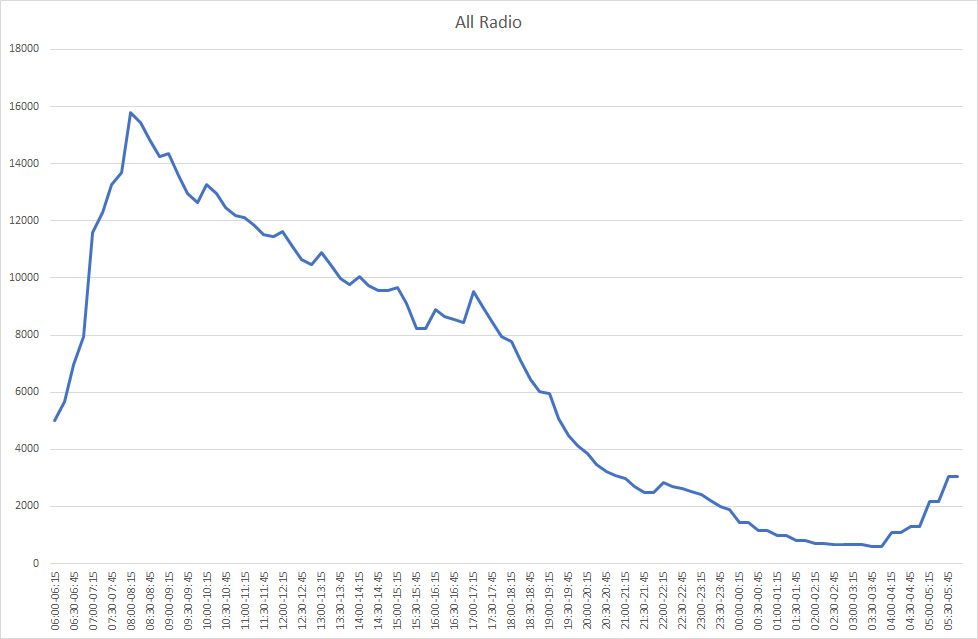
It shows a very traditional pattern. The peak time for listening to the radio is 8.00-8.15am – that’s why all those big interviews on Radio 4’s Today programme get broadcast at 8.10.
After the breakfast peak, it slips away during the day until it jumps up again for another small peak during drivetime – 17.00-17.15 to be precise.
Listening then diminishes rapidly during the evening, only the pick up again the early morning when those who set off to work early start waking up and turning the radio on.
So that’s what we’ve come to expect, and to be honest, most stations have that kind of pattern. Here’s Classic FM’s to give you an idea.

There are differences though. Classic’s audience peaks at 9.00-9.15am – not quite the rush for work amongst its older audience. And there’s no real evening drivetime peak. Perhaps because not as many are driving home from work. But the pattern is similar.
Now here’s Radio 4’s chart.

This is different. There are decided peaks during the key news bulletins of the day. Today gets a massive peak, sliding away quite rapidly after 9.00. Then there’s a bump for “WATO” – The World at One. And another big bump for PM and the Six O’Clock News. Finally there’s the 10pm World Tonight peak as well. News makes the station tick.

Radio 2 is a little unusual, and perhaps the new breakfast show needs to bed in. The peak here is during Ken Bruce. But there’s still a drive “plateau” before it falls away into evenings and overnights.
Finally, here’s LBC.
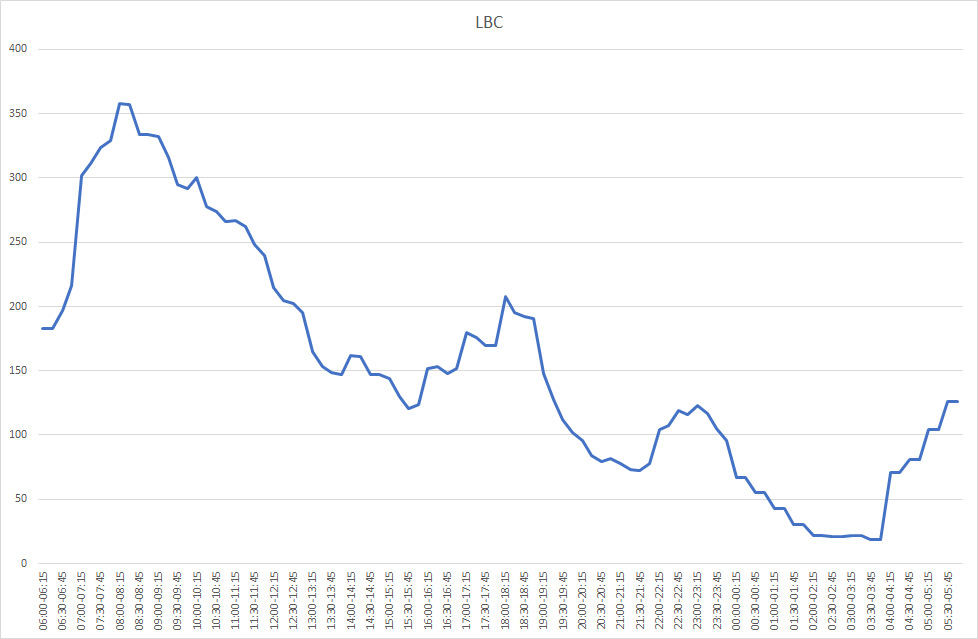
Yes, there’s a breakfast peak. And there’s another at drive (Eddie Mair lest we forget), but check out that bump at 22.00. That’s those late phone-ins. And there’s also a big lift at 4.00 when Steve Allen comes on for early breakfast. In London, those out-of-hours peaks are even more pronounced.
So the average is the average. But not every station behaves the same.
Further Reading
For more RAJAR analysis, I’d recommend the following sites:
The official RAJAR site and their infographic
Radio Today for a digest of all the main news
Go to Media.Info for lots of numbers and charts
Mediatel’s Newsline will have lots of figures and analysis
Paul Easton for more lots analysis including London charts
Matt Deegan will have some great analysis
The BBC Mediacentre for BBC Radio stats and findings
Bauer Media’s corporate site
Global Radio’s corporate site
Radiocentre’s take is here
All my previous RAJAR analyses are here.
Source: RAJAR/Ipsos MORI/RSMB, period ending 23 June 2019, Adults 15+. Also of note is that I treat all weekday shows as Mon-Fri except where specified. Some presenters have Friday off, but to compare like with like, I’ve stuck with a five day week.
Disclaimer: These are my views alone and do not represent those of anyone else, including my employer. Any errors (I hope there aren’t any!) are mine alone. Drop me a note if you want clarifications on anything. Access to the RAJAR data is via RALF from DP Software as mentioned at the top of this post.

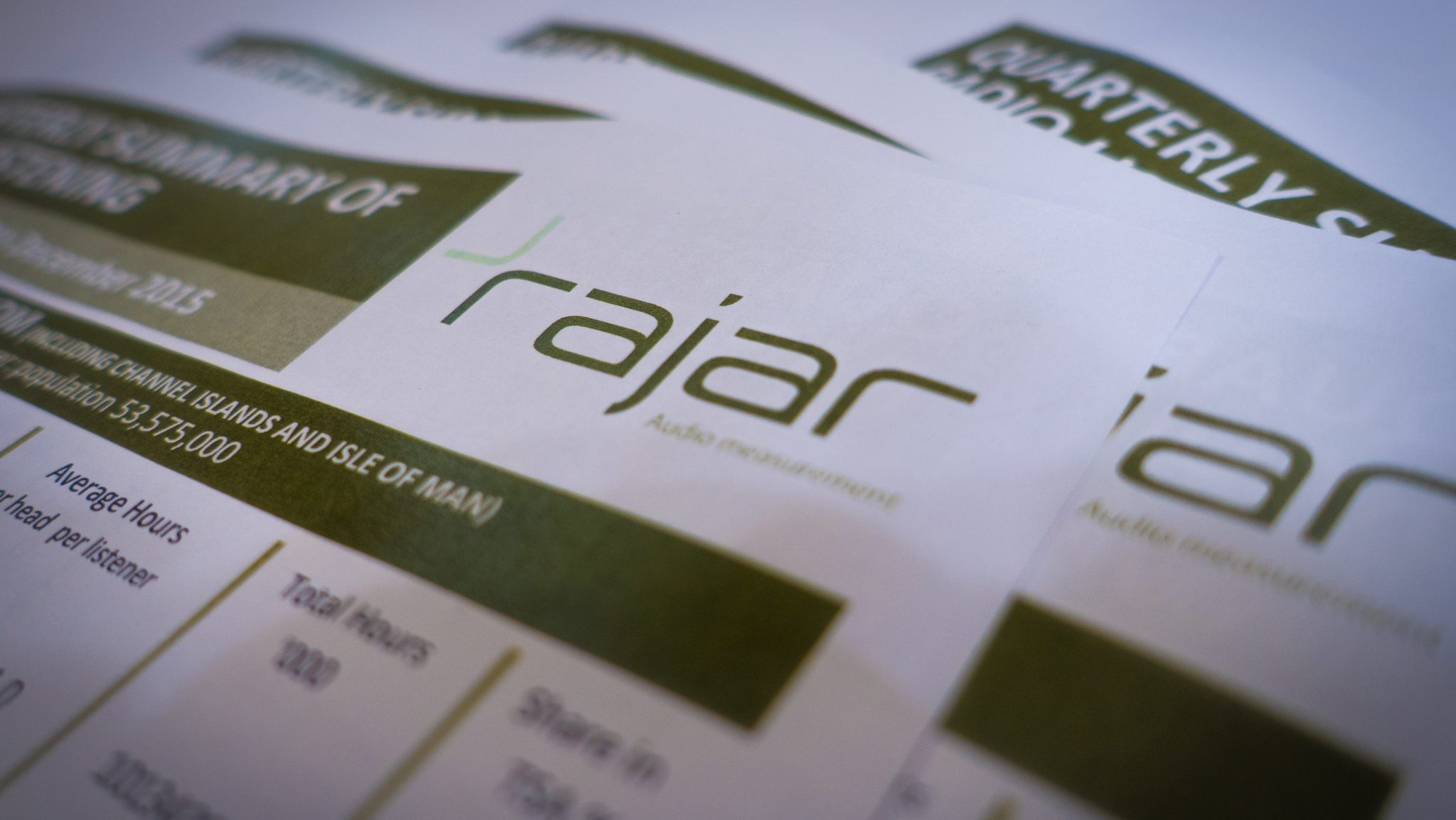
Comments
3 responses to “RAJAR Q2 2019”
Thank you for preparing this Adam, very interesting. Any chance of a similar chart for talkRadio?
Brilliant post Adam, thank you. To what do you attribute the quarterly increase for LBC London News?
@Mike – I imagine that TalkRadio’s chart would look much like LBC’s.
@Colin – Thanks. I couldn’t definitively say, but if I had to guess, I think the broader public got a bit bored of Brexit (we’d passed a deadline), whereas those who want to interact flocked to LBC. But that’s just a hypothesis. RAJAR can’t really tell you that!